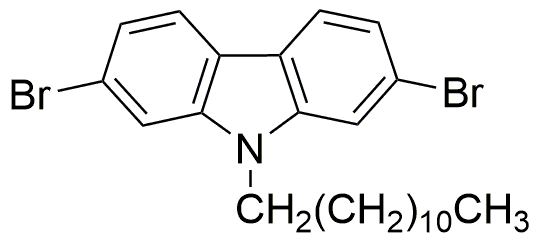2,7-Dibromo-9-dodecylcarbazole is widely utilized in research focused on:
- Organic Electronics: This compound is used in the development of organic light-emitting diodes (OLEDs) and organic photovoltaics (OPVs), enhancing light emission and energy conversion efficiency.
- Polymer Chemistry: It serves as a building block for creating novel polymers with specific electronic properties, which can be applied in flexible electronics and advanced materials.
- Fluorescent Probes: The compound is effective in designing fluorescent probes for biological imaging, allowing researchers to visualize cellular processes with high specificity.
- Photovoltaic Devices: Its unique structure contributes to improved charge transport in solar cells, making it a valuable component in the quest for more efficient renewable energy solutions.
- Research in Photonics: This chemical is explored for its potential in photonic applications, particularly in the development of light-harvesting systems and sensors.
Informations générales
Propriétés
Sécurité et réglementation
Applications
2,7-Dibromo-9-dodecylcarbazole is widely utilized in research focused on:
- Organic Electronics: This compound is used in the development of organic light-emitting diodes (OLEDs) and organic photovoltaics (OPVs), enhancing light emission and energy conversion efficiency.
- Polymer Chemistry: It serves as a building block for creating novel polymers with specific electronic properties, which can be applied in flexible electronics and advanced materials.
- Fluorescent Probes: The compound is effective in designing fluorescent probes for biological imaging, allowing researchers to visualize cellular processes with high specificity.
- Photovoltaic Devices: Its unique structure contributes to improved charge transport in solar cells, making it a valuable component in the quest for more efficient renewable energy solutions.
- Research in Photonics: This chemical is explored for its potential in photonic applications, particularly in the development of light-harvesting systems and sensors.
Documents
Fiches de données de sécurité (FDS)
La FDS fournit des informations de sécurité complètes sur la manipulation, le stockage et l’élimination du produit.
Spécifications du produit (PS)
Le PS fournit une description complète des propriétés du produit, notamment sa composition chimique, son état physique, sa pureté et les exigences de stockage. Il détaille également les plages de qualité acceptables et les applications prévues du produit.
Certificats d'analyse (COA)
Recherchez des certificats d'analyse (COA) en saisissant le numéro de lot du produit. Les numéros de lot et de lot se trouvent sur l'étiquette d'un produit, après les mots « Lot » ou « Lot de fabrication ».
Numéro de catalogue
Numéro de lot/série
Certificats d'origine (COO)
Ce certificat d'exploitation confirme le pays dans lequel le produit a été fabriqué, et détaille également les matériaux et composants utilisés et s'il est issu de sources naturelles, synthétiques ou autres sources spécifiques. Ce certificat peut être requis pour les douanes, le commerce et la conformité réglementaire.
Numéro de catalogue
Numéro de lot/série
Fiches de données de sécurité (FDS)
La FDS fournit des informations de sécurité complètes sur la manipulation, le stockage et l’élimination du produit.
DownloadSpécifications du produit (PS)
Le PS fournit une description complète des propriétés du produit, notamment sa composition chimique, son état physique, sa pureté et les exigences de stockage. Il détaille également les plages de qualité acceptables et les applications prévues du produit.
DownloadCertificats d'analyse (COA)
Recherchez des certificats d'analyse (COA) en saisissant le numéro de lot du produit. Les numéros de lot et de lot se trouvent sur l'étiquette d'un produit, après les mots « Lot » ou « Lot de fabrication ».
Numéro de catalogue
Numéro de lot/série
Certificats d'origine (COO)
Ce certificat d'exploitation confirme le pays dans lequel le produit a été fabriqué, et détaille également les matériaux et composants utilisés et s'il est issu de sources naturelles, synthétiques ou autres sources spécifiques. Ce certificat peut être requis pour les douanes, le commerce et la conformité réglementaire.


